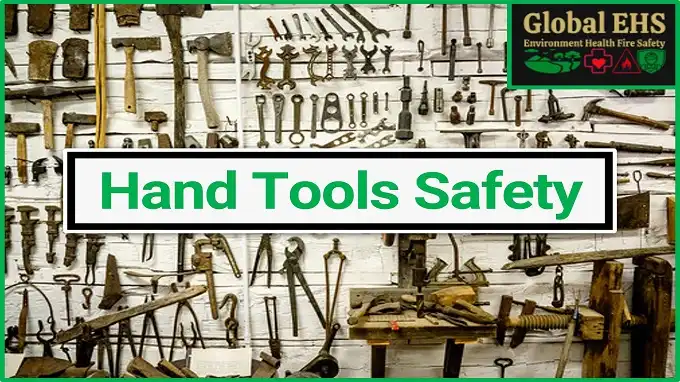The Importance of Hand Tools safety
- Hand tools are essential to our work, but their usage requires proper knowledge and attention to safety.
- Right tool for assigned task ensures that we stay safe and productive on the job.
- From wrenches to screwdrivers, they assist us to complete different assignments successfully.
- Notwithstanding, inappropriate use can lead to injuries and accidents.
- By understanding and adhering to safety practices, we add to a more safer workplace.
Bullets points for safety while using hand tools:
Choosing the Right Tool:
- Choosing the appropriate tool for a task is the first step in working safely and efficiently.
- Using the wrong tool can damage the tool itself and the materials we’re working on.
- Prepare and follow schedule for housekeeping.
- We should continuously pause for a minute to choose the right device to get everything taken care of.
Inspection Before Use:
- Regular inspections of hand tools are crucial.
- Check for signs of wear and tear, such as cracked handles, rust, or loose parts.
- Using damaged tools can lead to unexpected accidents. If you find a tool that needs attention, report it immediately so it can be repaired or replaced.
Handling and Grip:
- Maintaining a proper grip on hand tools is essential for safety. Incorrect grip can lead to loss of control and injuries.
- Use devices with non-slip handles, and keep your wrist straight while utilizing them. These simple steps can prevent strain and discomfort.
Utilizing the Right Procedure:
- Each tool has its own technique for protected and proficient use.
- For example, while using hammer, hit with the full face instead of the edge. When using pliers, grip materials squarely to prevent slipping.
- Continuously adhere to producer rules and preparing if all else fails.
Personal Protective Equipment (PPE):
- Wearing the right PPE adds an additional layer of safety.
- Contingent upon the undertaking, we could require gloves, security goggles, or hearing protection.
- Let’s ensure we’re equipped with the right gear before starting any job.
Storage and Maintenance:
- Proper storage and maintenance extend the life of our hand tools.
- Keep them in a dry and organized space to prevent rust and damage.
- Regularly clean and lubricate moving parts to ensure they function smoothly.
Reporting Issues:
- In the event that you run over a harmed or failing hand tool during your work, report it promptly to your support group.
- Resolving issues quickly prevent accidents and guarantees that all tools are safe to use.
Emergency Response:
- In the event of an accident, knowing basic first aid measures is essential.
- Keep a first aid kit nearby and know who to contact in case of emergencies.
- Our safety is a collective responsibility.
Hazards of Hand Tools:
Cuts and Lacerations:
- Sharp edges and blades on tools like knives, chisels, and saws can lead to cuts and lacerations if not handled carefully.
Strain and Overexertion:
- Using hand tools that require excessive force can lead to muscle strains, overexertion, and repetitive strain injuries over time.
Impact Injuries:
- Tools like hammers, mallets, and wrenches can cause impact injuries if they slip or are used incorrectly, leading to bruises, fractures, or even more serious injuries.
Flying Particles:
- When using tools like chisels, grinders, or drills, flying debris or particles can pose a risk to the eyes and skin if proper protective gear isn’t worn.
Electric Shock:
- Electric hand tools like drills and saws can cause electric shock if they’re not properly grounded, or if damaged cords or faulty wiring are present.
Pinching and Crushing:
- Tools with moving parts or mechanisms, such as pliers, can cause pinching and crushing injuries to fingers or other body parts.
Chemical Exposure:
- Some hand tools are used in conjunction with chemicals or solvents, and improper handling or storage of these substances can lead to chemical burns or inhalation hazards.
Vibration Injuries:
- Prolonged use of hand tools that produce vibrations, such as power drills or jackhammers, can lead to hand-arm vibration syndrome, causing numbness, tingling, and reduced dexterity.
Tool Malfunction:
- Poorly maintained or damaged tools can malfunction during use, potentially causing accidents or injuries.
Falling Objects:
- Tools that are improperly secured when working at heights can fall and pose a hazard to workers below.
Heat and Burns:
- Tools that generate heat, like soldering irons or welding equipment, can cause burns if they come into contact with skin or flammable materials.
Eye Injuries:
- Failure to use proper eye protection when using tools that create sparks, dust, or debris can lead to eye injuries.
Loud Noise:
- Some hand tools, such as impact wrenches and power saws, generate loud noise levels that can lead to hearing damage if proper hearing protection isn’t used.
Improper Ergonomics:
- Using hand tools with poor ergonomics can lead to discomfort, fatigue, and musculoskeletal disorders.
Inadequate Training:
- Lack of proper training in using specific tools can lead to incorrect techniques and potential accidents.

Prevention and control measures from hazards of hand tools:
Training and Education:
- Provide comprehensive training on the correct use of each hand tool.
- Train users on proper ergonomics, body posture, and techniques to minimize strain.
Personal Protective Equipment (PPE):
- Require appropriate PPE, such as gloves, safety glasses, hearing protection, and respiratory protection, depending on the tool and task.
- Ensure PPE fits properly and is in good condition.
Tool Selection:
- Choose tools that are ergonomically designed and suited for the task.
- Select tools with built-in safety features, such as guards and shields.
Inspection and Maintenance:
- Regularly inspect tools for damage, wear, and defects before use.
- Maintain tools according to manufacturer guidelines.
Tool Storage:
- Store tools properly in designated areas or toolboxes to prevent tripping hazards.
- Keep cutting edges covered or protected when not in use.
Proper Use:
- Use tools only for their intended purposes.
- Follow manufacturer instructions for usage and maintenance.
Work Environment:
- Ensure adequate lighting and ventilation in the workspace.
- Keep the work area clean and organized to minimize trip hazards.
Secure Workpieces:
- Securely clamp or stabilize workpieces before using tools like saws or drills to prevent movement or slipping.
Hand Placement:
- Keep hands and body parts clear of the path of the tool’s motion.
- Use tools with handles or grips designed to prevent accidental contact with moving parts.
Electric Tools:
- Inspect cords and plugs for damage before use.
- Disconnect tools from power sources before changing accessories or making adjustments.
Vibration Control:
- Use tools with vibration-dampening features.
- Take breaks during tasks that involve prolonged vibration.
Chemical Handling:
- Follow proper handling and storage procedures for chemicals used with hand tools.
- Use chemical-resistant gloves and eye protection when necessary.
Fall Protection:
- Use proper fall protection equipment when working at heights.
- Secure tools to prevent them from falling and causing injury.
Emergency Preparedness:
- Have a first aid kit readily available in case of injuries.
- Train employees in basic first aid and how to respond to tool-related accidents.
Regular Review and Feedback:
- Encourage employees to report unsafe conditions or incidents.
- Conduct regular safety reviews and seek input from workers to identify and address potential hazards.

